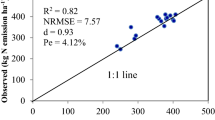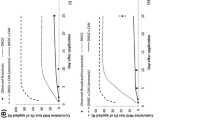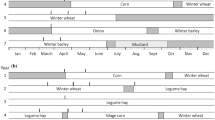Abstract
Aims
Process-based biogeochemical models can be used to simulate soil nitrous oxide (N2O) fluxes and maize yields and draw insights on yields improvement and climate change mitigation options. We compared both observed and DeNitrification-DeComposition (DNDC) simulated soil N2O fluxes and maize yields.
Methods
We used DNDC model to simulate soil N2O fluxes and maize yields under four soil fertility treatments (inorganic fertiliser, animal manure, animal manure + inorganic fertiliser and control,) replicated thrice for 1 year in Central Highlands of Kenya. We sampled soil N2O fluxes using static chambers installed in each plot. We analysed soil N2O using gas chromatography and calculated cumulative fluxes using trapezoidal rule linear interpolation between sampling dates.
Results
DNDC showed poor results in simulating daily N2O fluxes (157.16% ≤ normalised root mean square error (nRMSE) ≤ 324.01% and 0.90 ≤ modelling efficiency (NSE) ≤ 0.96), good to excellent performance in simulating cumulative annual soil N2O fluxes (6.16 ≤ nRMSE ≤12.86 and 0.63 ≤ NSE ≤ 0.86) and good to excellent performance in simulating maize yields (1.15% ≤ nRMSE ≤13.86% and 0.51 ≤ NSE ≤ 0.88) across all soil fertility treatments.
Conclusion
The DNDC model had good to excellent performance in simulating cumulative soil N2O fluxes and crop yields across treatments. Though the model captured yield-scaled N2O fluxes and N2O emission factors across treatments, they were underestimated under manure treatment. There is a need to continue calibrating the DNDC model for improved capture of daily N2O fluxes and uptakes on Kenyan soils.




Similar content being viewed by others
References
Abdalla M, Rueangritsarakul K, Jones M, Osborne B, Helmy M, Roth B, Burke J, Nolan P, Smith P, Williams M (2012) How effective is reduced tillage–cover crop management in reducing N2O fluxes from arable crop soils? Water Air Soil Pollut 223:5155–5174. https://doi.org/10.1007/s11270-012-1268-4
Abdalla M, Song X, Ju X, Topp CF, Smith P (2020) Calibration and validation of the DNDC model to estimate nitrous oxide emissions and crop productivity for a summer maize-winter wheat double cropping system in Hebei, China. Environ Pollut (Barking, Essex 1987) 262:114199. https://doi.org/10.1016/j.envpol.2020.114199
Arias-Navarro C, Díaz-Pinés E, Kiese R, Rosenstock TS, Rufino MC, Stern D, Neufeldt H, Verchot LV, Butterbach-Bahl K (2013) Gas pooling: a sampling technique to overcome spatial heterogeneity of soil carbon dioxide and nitrous oxide fluxes. Soil Biol Biochem 67:20–23. https://doi.org/10.1016/j.soilbio.2013.08.011
Barton L, Wolf B, Rowlings D, Scheer C, Kiese R, Grace P, Stefanova K, Butterbach-Bahl K (2015) Sampling frequency affects estimates of annual nitrous oxide fluxes. Sci Rep 5:15912. https://doi.org/10.1038/srep15912
Budiman B, Steiner C, Topp CF, Buerkert A (2020) Soil–climate contribution to DNDC model uncertainty in simulating biomass accumulation under urban vegetable production on a Petroplinthic Cambisol in tamale, Ghana. J Plant Nutr Soil Sci 183:306–315. https://doi.org/10.1002/jpln.201900514
Butterbach-Bahl K, Baggs EM, Dannenmann M, Kiese R, Zechmeister-Boltenstern S (2013) Nitrous oxide emissions from soils: how well do we understand the processes and their controls? Philos Trans R Soc B Biol Sci 368:20130122. https://doi.org/10.1098/rstb.2013.0122
Chapuis-Lardy L, Wrage N, Metay A, Chotte JL, Bernoux M (2007) Soils, a sink for N2O? A review. Global Change Biol 13:1–17. https://doi.org/10.1111/j.1365-2486.2006.01280.x
Cui F, Zheng X, Liu C, Wang K, Zhou Z, Deng J (2014) Assessing biogeochemical effects and best management practice for a wheat–maize cropping system using the DNDC model. Biogeosciences 11:91–107. https://doi.org/10.5194/bg-11-91-2014
Deng Q, Hui D, Wang J, Yu CL, Li C, Reddy KC, Dennis S (2016) Assessing the impacts of tillage and fertilisation management on nitrous oxide emissions in a cornfield using the DNDC model. J Geophys Res Biogeosci 121:337–349. https://doi.org/10.1002/2015JG003239
Dutta B, Grant BB, Campbell CA, Lemke RL, Desjardins RL, Smith WN (2017) A multi model evaluation of long-term effects of crop management and cropping systems on nitrogen dynamics in the Canadian semi-arid prairie. Agric Syst 151:136–147. https://doi.org/10.1016/j.agsy.2016.12.003
FAO (2017) The future of food and agriculture–trends and challenges. Annual Report. Rome
Giltrap D, Saggar S, Li C, Wilde H (2008) Using the NZ–DNDC model to estimate agricultural N2O emissions in the Manawatu–Wanganui region. Plant Soil 309:191–209. https://doi.org/10.1007/s11104-007-9527-7
Giltrap DL, Ausseil AGE, Thakur KP, Sutherland MA (2013) Investigating a method for estimating direct nitrous oxide emissions from grazed pasture soils in New Zealand using NZ-DNDC. Sci Total Environ 465:7–16. https://doi.org/10.1016/j.scitotenv.2013.03.053
Giltrap DL, Li C, Saggar S (2010) DNDC: a process-based model of greenhouse gas fluxes from agricultural soils. Agric Ecosyst Environ 136:292–300. https://doi.org/10.1016/j.agee.2009.06.014
Giltrap DL, Vogeler I, Cichota R, Luo J, Van Der Weerden TJ, De Klein CAM (2015) Comparison between APSIM and NZ-DNDC models when describing N-dynamics under urine patches. New Zeal J Agric Res 58:131–155. https://doi.org/10.1080/00288233.2014.987876
He W, Dutta B, Grant BB, Chantigny MH, Hunt D, Bittman S, Tenuta M, Worth D, VanderZaag A, Desjardins RL, Smith WN (2020) Assessing the effects of manure application rate and timing on nitrous oxide emissions from managed grasslands under contrasting climate in Canada. Sci Total Environ 716:135374. https://doi.org/10.1016/j.scitotenv.2019.135374
Hickman JE, Havlikova M, Kroeze C, Palm CA (2011) Current and future nitrous oxide emissions from African agriculture. Curr Opin Environ Sustain 3:370–378. https://doi.org/10.1016/j.cosust.2011.08.001
Hickman JE, Palm CA, Mutuo P, Melillo JM, Tang J (2014) Nitrous oxide (N2O) emissions in response to increasing fertiliser addition in maize (Zea mays L.) agriculture in western Kenya. Nutr Cycling Agroecosyst 100:177–187. https://doi.org/10.1007/s10705-014-9636-7
Hu L, Qiu J, Wang L, Yang L (2011) Advance in a terrestrial biogeochemical model—DNDC model. Acta Ecol Sin 31:91–96. https://doi.org/10.1016/j.chnaes.2010.11.006
IPCC (2014) In: Pachauri RK, Meyer LA (eds) Climate change 2014: synthesis report. Contribution of working groups I, II and III to the fifth assessment report of the intergovernmental panel on climate change. Switzerland Core Writing Team, IPCC, Geneva
Jaetzold R, Schmidt H, Hornet ZB, Shisanya CA (2007) Farm management handbook of Kenya. Natural conditions and farm information. 2nd edition. Vol.11/ C Eastern Province. Ministry of Agriculture/GTZ, Nairobi, Kenya
Jiang R, He W, Zhou W, Hou Y, Yang JY, He P (2019) Exploring management strategies to improve maize yield and nitrogen use efficiency in Northeast China using the DNDC and DSSAT models. Comput Electron Agric 166:104988. https://doi.org/10.1016/j.compag.2019.104988
Kc KB, Dias GM, Veeramani A, Swanton CJ, Fraser D, Steinke D, Lee E, Wittman H, Farber JM, Dunfield K, McCann K (2018) When too much isn't enough: does current food production meet global nutritional needs? PLoS One 13:e0205683. https://doi.org/10.1371/journal.pone.0205683
Kihara J, Bolo P, Kinyua M, Nyawira SS, Sommer R (2020) Soil health and ecosystem services: lessons from sub-Sahara Africa (SSA). Geoderma 370:114342. https://doi.org/10.1016/j.geoderma.2020.114342
Kim DG, Giltrap D, Hernandez-Ramirez G (2013) Background nitrous oxide emissions in agricultural and natural lands: a meta-analysis. Plant Soil 373:17–30. https://doi.org/10.1007/s11104-013-1883-x
Li C (2012) User's guide for the DNDC model (version 9.5). Institute for the Study of earth, oceans and space, University of new Hampshire, Durham, NC, USA
Li C, Frolking S, Frolking TA (1992) A model of nitrous oxide evolution from soil driven by rainfall events: 1. Model structure and sensitivity. J Geophys Res Atmos 97:9759–9776. https://doi.org/10.1029/92JD00509
Li H, Qiu J, Wang L, Tang H, Li C, Van Ranst E (2010) Modelling impacts of alternative farming management practices on greenhouse gas emissions from a winter wheat–maize rotation system in China. Agric Ecosyst Environ 135:24–33. https://doi.org/10.1016/j.agee.2009.08.003
Li H, Wang L, Qiu J, Li C, Gao M, Gao C (2014) Calibration of DNDC model for nitrate leaching from an intensively cultivated region of northern China. Geoderma 223:108–118. https://doi.org/10.1016/j.geoderma.2014.01.002
Lv F, Song J, Giltrap D, Feng Y, Yang X, Zhang S (2020) Crop yield and N2O emission affected by long-term organic manure substitution fertiliser under winter wheat-summer maize cropping system. Sci Total Environ 732:139321. https://doi.org/10.1016/j.scitotenv.2020.139321
Macharia JM, Pelster DE, Ngetich FK, Shisanya CA, Mucheru-Muna M, Mugendi DN (2020) Soil greenhouse gas fluxes from maize production under different soil fertility management practices in East Africa. J Geophys Res Biogeosci 125:e2019JG005427. https://doi.org/10.1029/2019JG005427
Moriasi DN, Arnold JG, Van Liew MW, Bingner RL, Harmel RD, Veith TL (2007) Model evaluation guidelines for systematic quantification of accuracy in watershed simulations. Trans ASABE 50:885–900. https://doi.org/10.13031/2013.23153
Musafiri CM, Macharia JM, Kiboi MN, Ng’etich OK, Shisanya CA, Okeyo JM, Mugendi DN, Okwuosa EA, Ngetich FK (2020a) Soil greenhouse gas fluxes from maize cropping system under different soil fertility management technologies in Kenya. Agric Ecosyst Environ 301:107064. https://doi.org/10.1016/j.agee.2020.107064
Musafiri CM, Macharia JM, Kiboi MN, Ng’etich OK, Shisanya CA, Okeyo JM, Mugendi DN, Okwuosa EA, Ngetich FK (2020b) Farming systems’ typologies analysis to inform agricultural greenhouse gas emissions potential from smallholder rain-fed farms in Kenya. Sci African 8:e00458. https://doi.org/10.1016/j.sciaf.2020.e00458
Nash JE, Sutcliffe JV (1970) River flow forecasting through conceptual models part I—A discussion of principles. J Hydrol 10:282–290. https://doi.org/10.1016/0022-1694(70)90255-6
Ngetich KF, Diels J, Shisanya CA, Mugwe JN, Mucheru-Muna M, Mugendi DN (2014) Effects of selected soil and water conservation techniques on runoff, sediment yield and maize productivity under sub-humid and semi-arid conditions in Kenya. Catena 121:288–296. https://doi.org/10.1016/j.catena.2014.05.026
Okalebo JR, Gathua KW, Woomer PL (2002) Laboratory methods of soil and plant analysis: a working manual second edition. Sacred Africa, Nairobi, p 21
Ortiz-Gonzalo D, de Neergaard A, Vaast P, Suárez-Villanueva V, Oelofse M, Rosenstock TS (2018) Multi-scale measurements show limited soil greenhouse gas emissions in Kenyan smallholder coffee-dairy systems. Sci Total Environ 626:328–339. https://doi.org/10.1016/j.scitotenv.2017.12.247
Parkin TB, Venterea RT (2010) USDA-ARS GRACEnet project protocols, chapter 3. Chamber-based Trace Gas Flux Measurements. Sampling protocols, Beltsville, MD, pp 1–39
Parkin TB, Venterea RT, Hargreaves SK (2012) Calculating the detection limits of chamber-based soil greenhouse gas flux measurements. J Environ Qual 41:705–715. https://doi.org/10.2134/jeq2011.0394
Pauw WP, Klein RJ, Mbeva K, Dzebo A, Cassanmagnago D, Rudloff A (2018) Beyond headline mitigation numbers: we need more transparent and comparable NDCs to achieve the Paris agreement on climate change. Clim Chang 147:23–29. https://doi.org/10.1007/s10584-017-2122-x
Pelster DE, Chantigny MH, Rochette P, Angers DA, Rieux C, Vanasse A (2012) Nitrous oxide emissions respond differently to mineral and organic nitrogen sources in contrasting soil types. J Environ Qual 41:427–435. https://doi.org/10.2134/jeq2011.0261
Rafique R, Fienen MN, Parkin TB, Anex RP (2013) Nitrous oxide emissions from cropland: a procedure for calibrating the DayCent biogeochemical model using inverse modelling. Water Air Soil Pollut 224:1–15. https://doi.org/10.1007/s11270-013-1677-z
Rafique R, Peichl M, Hennessy D, Kiely G (2011) Evaluating management effects on nitrous oxide emissions from grasslands using the process-based DeNitrification–DeComposition (DNDC) model. Atmos Environ 45:6029–6039. https://doi.org/10.1016/j.atmosenv.2011.07.046
Ri X, Wang Y, Zheng X, Ji B, Wang M (2003) A comparison between measured and modeled N2O emissions from inner Mongolian semi-arid grassland. Plant Soil 255:513–528
Rochette P, Angers DA, Chantigny MH, Gagnon B, Bertrand N (2008) N2O fluxes in soils of contrasting textures fertilized with liquid and solid dairy cattle manures. Can. J. Soil Sci 88:175–187. https://doi.org/10.4141/CJSS06016
Rosenstock TS, Mpanda M, Pelster DE, Butterbach-Bahl K, Rufino MC, Thiong'o M, Mutuo P, Abwanda S, Rioux J, Kimaro AA, Neufeldt H (2016) Greenhouse gas fluxes from agricultural soils of Kenya and Tanzania. J Geophys Res Biogeosci 121:1568–1580. https://doi.org/10.1002/2016JG003341
Schlesinger WH (2013) An estimate of the global sink for nitrous oxide in soils. Glob Chang Biol 19:2929–2931. https://doi.org/10.1111/gcb.12239
Signor D, Cerri CEP (2013) Nitrous oxide emissions in agricultural soils: a review. Pesqui Agropecuária Trop 43:322–338. https://doi.org/10.1590/S1983-40632013000300014
Smith KA (2017) Changing views of nitrous oxide emissions from agricultural soil: key controlling processes and assessment at different spatial scales. Eur J Soil Sci 68:137–155. https://doi.org/10.1111/ejss.12409
Smith P, Martino D, Cai Z, Gwary D, Janzen H, Kumar P, McCarl B, Ogle S, O'Mara F, Rice C, Scholes B, Sirotenko O (2007) Agriculture. In: Metz B, Davidson OR, Bosch PR, Dave R, Meyer LA (eds) Climate change 2007: mitigation. Contribution of working group III to the fourth assessment report of the intergovernmental panel on climate change. Cambridge University Press, Cambridge, United Kingdom and New York, NY, USA
Smith W, Grant B, Qi Z, He W, VanderZaag A, Drury CF, Helmers M (2020) Development of the DNDC model to improve soil hydrology and incorporate mechanistic tile drainage: a comparative analysis with RZWQM2. Environ Model Softw 123:104577. https://doi.org/10.1016/j.envsoft.2019.104577
Smith WN, Grant BB, Desjardins RL, Rochette P, Drury CF, Li C (2008) Evaluation of two process-based models to estimate soil N2O emissions in eastern Canada. Can J Soil Sci 88:251–260. https://doi.org/10.4141/CJSS06030
Smith WN, Grant BB, Desjardins RL, Worth D, Li C, Boles SH, Huffman EC (2010) A tool to link agricultural activity data with the DNDC model to estimate GHG emission factors in Canada. Agric Ecosyst Environ 136:301–309. https://doi.org/10.1016/j.agee.2009.12.008
Uzoma KC, Smith W, Grant B, Desjardins RL, Gao X, Hanis K, Tenuta M, Goglio P, Li C (2015) Assessing the effects of agricultural management on nitrous oxide emissions using flux measurements and the DNDC model. Agric Ecosyst Environ 206:71–83. https://doi.org/10.1016/j.agee.2015.03.014
Van Groenigen JW, Velthof GL, Oenema O, Van Groenigen KJ, Van Kessel C (2010) Towards an agronomic assessment of N2O emissions: a case study for arable crops. Eur J Soil Sci 61:903–913. https://doi.org/10.1111/j.1365-2389.2009.01217.x
Wang J, Zhang X, Liu Y, Pan X, Liu P, Chen Z, Huang T, Xiong Z (2012) Modeling impacts of alternative practices on net global warming potential and greenhouse gas intensity from rice–wheat annual rotation in China. PLoS One 7:e45668. https://doi.org/10.1371/journal.pone.0045668
Zhang YT, Jian LIU, Wang HY, Lei QL, Liu HB, Zhai LM, Ren TZ, Zhang JZ (2018) Suitability of the DNDC model to simulate yield production and nitrogen uptake for maize and soybean intercropping in the North China plain. J Integr Agric 17:2790–2801. https://doi.org/10.1016/S2095-3119(18)61945-8
Acknowledgements
We acknowledge the three farmers whose farms were used for the field experiment. We thank the International Livestock Research Institute, Mazingira Centre, for providing static chambers and carrying out GHG analysis.
Availability of data and material
All data generated or analysed during this study are included in this published article.
Code availability
Not applicable.
Funding
We acknowledge funding support from the National Research Fund (NRF) Kenya through the University of Embu Multi-disciplinary project; “Towards quantifying greenhouse gas emissions and deriving emission factors from organic and inorganic fertilised farming systems of Kenya.”
Author information
Authors and Affiliations
Contributions
CMM, JMM, and FKN conceived this research and designed experiments; CMM performed experiments and analysis; CMM, OKN, CAS, JMO, EAO, MNK participated in the design and interpretation of the data. CMM, JMM, MNK, FKN wrote the paper and participated in the revisions of it. All authors read and approved the final manuscript.
Corresponding author
Ethics declarations
Conflicts of interest/competing interests
The authors declare that they have no potential conflict of interest in relation to the study in this paper.
Ethics approval
Not applicable.
Consent to participate
Not applicable.
Consent for publication
All authors are aware of the submission and consent to it.
Conflict of interest
The authors declare no conflict of interest.
Additional information
Responsible Editor: Elizabeth M Baggs.
Publisher’s note
Springer Nature remains neutral with regard to jurisdictional claims in published maps and institutional affiliations.
Rights and permissions
About this article
Cite this article
Musafiri, C.M., Macharia, J.M., Kiboi, M.N. et al. Comparison between observed and DeNitrification-DeComposition model-based nitrous oxide fluxes and maize yields under selected soil fertility management technologies in Kenya. Plant Soil 463, 395–413 (2021). https://doi.org/10.1007/s11104-021-04924-x
Received:
Accepted:
Published:
Issue Date:
DOI: https://doi.org/10.1007/s11104-021-04924-x




